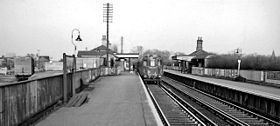Number of tracks 2 | Status Operational | |
 | ||
Terminis Charing Cross railway station, Dartford railway station | ||
The Dartford Loop Line (often referred to as the Sidcup Line) is one of three lines linking London with Dartford in Kent, England. It lies to the south of the other two: the North Kent Line and the Bexleyheath Line.
Contents
History
In June 1862 the South Eastern Railway obtained powers for a second 10-mile (16 km) line between London and Dartford from a junction with the main line at Hither Green to its existing North Kent line to reduce congestion on the existing line and to give a more direct route between London and Dartford. This was to be routed via the town of Sidcup.
The Dartford Loop Line opened on 1 September 1866. A loop line in railway terminology is a line which leaves the main line and then rejoins. The line initially had only five new stations : Lee, Eltham (now Mottingham), Sidcup, Bexley and Crayford. The station at Hither Green, near Lewisham, where the line deviates from the main line, was built after the opening of the third North Kent route, the Bexleyheath Line in 1895.
Pope Street, now New Eltham station, opened in 1878 between Eltham and Sidcup stations. Hither Green finally opened in 1895 serving both the Dartford Loop Line and the main line via Tonbridge. The final station to open was Albany Park in 1935. The Loop Line originally passed through mainly open country and farm land but it stimulated development around the new stations.
In 1899 the Lee Spur, a double track link between the up line of the Dartford Loop Line and the Hither Green marshalling yard, was built. The spur is occasionally used by freight and engineering works trains.
The Loop Line was electrified by the Southern Railway in 1926 along with the two other lines to Dartford.
In 1942 a double-track loop (the ‘Dartford Loop’) came into use between the North Kent and Dartford Loop Lines, creating a triangular junction. This allowed direct running between the two routes, avoiding the need for a reversing manoeuvre at Dartford.
In 1955 the platforms on all Loop Line stations were extended to accommodate ten-carriage trains, whilst continuing standard operation of eight-car trains. Most stations had goods yards which closed during the 1960s and became car parks.
In the late 1960s the Dartford Loop Line along with the two other North Kent routes were re-signalled which saw the replacement of semaphores with colour light signals. In November 1970 most of the mechanical signal boxes on the line closed. In the mid-late 2000s the Dartford Area Resignalling Scheme saw the line resignalled.
Infrastructure
The line is double track throughout and electrified at 750 DC third rail.
Stations
The line is a little over 8.7 miles (14.0 km) in length. The following are the stations served:
Future plans
The line was due to be served by Thameslink trains following the completion of the first phase of the Thameslink Programme. The 2008 Network Rail Route Utilisation Strategy, however, made clear that consideration of running Thameslink trains to Dartford by any route had been abandoned due to timetabling and pathing difficulties.
Service patterns
Train services are operated by Southeastern (train operating company). All services run to London Charing Cross or London Cannon Street.
Off-peak & Saturday:
Evenings & Sunday:
The London bound peak service is :
The Sidcup Line has always been a fairly busy freight route for trains to Kent. Most services use the Lewisham flyover via Nunhead.
Rolling stock
Rolling stock used on the line is Class 465 and Class 466 'Networkers' and Class 376 Suburban Electrostars.
Accidents
On 11 October 1977 the derailed wagons of an eastbound coal train were struck by a Northfleet to Dunstable cement train between Lee and Mottingham. The locomotive ended up at the bottom of a garden of a house in Mottingham. There were no serious human injuries but several caged budgerigars in the garden were killed.
On 4 February 1997 an EWS freight train derailed near Bexley station (the Bexley derailment).
